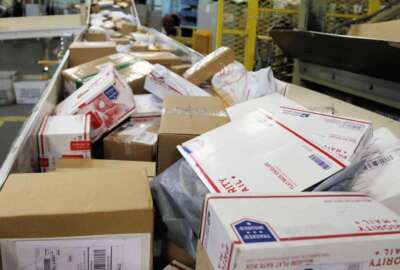

With USPS now keeping tracking the deaths of its employees from the coronavirus pandemic, the agency is doing everything it can to continue normal operations,
With the Postal Service now tracking the deaths of its employees from the coronavirus pandemic, in addition to a growing list of those who have tested positive for the virus, the agency is doing everything it can to continue normal operations — even in the most extraordinary circumstances.
The USPS Board of Governors held a moment of silence Wednesday for postal employees who have died of complications from COVID-19, the illness caused by the current strain of the virus.
Those include Rakkhon Kim, a 50-year old letter carrier in New York City, who died of complications from the virus last week, and Anthony Smith, a Detroit mail handler and the first mail handler, according to the National Postal Mail Handlers Union, who died from the coronavirus.
USPS spokesman Dave Partenheimer told Federal News Network that 230 postal employees have tested positive for COVID-19. While the Postal Service can confirm “some deaths,” the agency does not yet have a definitive number.
“This pandemic is an important reminder that the Postal Service provides an essential public service,” Robert Duncan, the board’s chair, said during the remote meeting. “And unfortunately, it’s also a sad and painful reminder that public service can come with a terrible price.”
While the health and safety of its employees remains a top concern, the Postal Service is also taking steps to address its worsening financial situation.
Duncan called the additional $10 billion line of credit in the $2 trillion emergency spending bill President Donald Trump signed last week “a good start” to see the Postal Service make it through this pandemic, but added USPS will continue to work with Congress on a path forward that addresses its underlying liabilities and its long-term financial health.
“The Postal Service continues to perform its public services [but] have seen that we’re not immune to the financial impacts of this pandemic,” he said. “At a time when we are being asked to do more, we’re generating much less in revenue. A sudden and dramatic drop in economic activity is also leading to a steep and precarious decline in mail volume.”
However, Rep. Gerry Connolly (D-Va.), chair of the House Oversight and Reform Committee’s government operations subcommittee, told Federal News Network that it would be “very unhelpful” for USPS to only borrow more money.
“To give it $10 billion of additional credit is, frankly, a meaningless gesture. It’s a slap in the face, and it’s not what they need,” Connolly said in an interview. “They don’t need more debt capacity, they need debt forgiveness.”
Connolly led efforts in the House-version of the emergency spending bill to give the Postal Service $25 billion to spend through September 2022. The bill would have also forgiven USPS’ $11 billion debt to the Treasury Department and allowed the agency to borrow another $15 billion.
The bill would have also eliminated a $3 billion annual borrowing limit for this line of credit from Treasury.
Connolly said he supports seeking further USPS emergency relief in a fourth round of emergency spending for critical infrastructure once the Senate reconvenes April 20. However, he added that the White House and President Donald Trump personally objected to some of the USPS provisions in the House spending bill.
Connolly also suggested adding the USPS Fairness Act, which passed the House in February, into the next spending bill. The bill would repeal a 2006 congressional mandate for the Postal Service to pre-fund the health benefits of future postal retirees, and would instead amove the agency to a pay-as-you-go model.
The White House’s National Security Council and the Department of Homeland Security consider USPS an “essential service” during the course of the pandemic. However, Connolly said the Trump administration has yet to give postal employees the resources and protections commensurate with this emergency designation.
“Many of them [are] working in risky situations in the midst of this pandemic to ensure Americans have the essential supplies they need in terms of medicine, prescription drugs, equipment, foodstuffs and the like,” he said. “We’re even talking about moving to an all-mail ballot, which, of course, would rely on a Postal Service that continues to do its job.”
Postmaster General Megan Brennan said during the board meeting that USPS does not expect significant disruptions in delivery service, but acknowledged cases where there may be “temporary, localized impacts” to service where the agency will “quickly recover” to resume normal operations.
The New York Post reported disruptions in USPS delivery in the Greenwich Village neighborhood of New York City because of the number of postal employees taking sick leave.
Meanwhile, the Postal Service stood up a COVID-19 Response Command led by Chief Information Officer Kristin Seaver to respond to what Brennan described as front-line conditions changing on a “day-to-day basis.”
“We are aggressively monitoring all aspects of our business operations and functions, and we are confident in our ability to process and deliver the nation’s mail and packages throughout this emergency,” Brennan said.
Several postal employees have told Federal News Network that their local post offices have been slow to provide surgical masks that USPS headquarters said would be available for all workers. Hand sanitizer, they added, has also been in short supply.
“We are continuing to work to overcome gaps in the supply chain to ensure that our employees have access to hand sanitizer, masks and gloves, and other personal protective equipment,” Brennan said.
Meanwhile, the Postal Service has reached agreements with postal unions on a liberal leave policy that would provide additional paid leave time for career employees and non-career city carrier assistants.
“We are promoting healthy behaviors and protocols and encouraging any employee who feels sick to stay home,” Brennan said.
To minimize the risk to customers and employees, USPS management has implemented social distancing protocols at post offices and changed work practices to limit contact when postal employees receive outgoing packages from customers and when they get signatures after making deliveries.
The Postal Service, Brennan said, has issued a “daily cadence” of memos on mandatory stand-up talks, articles, videos and other communications to ensure employees have the latest information and guidance from federal health officials.
“The Postal Service is focused on our service mission, processing and delivering the nation’s mail and packages and meeting the immediate and evolving needs of American citizens and businesses,” Brennan said. “We will get through this and the Postal Service will help lead the way.”
Copyright © 2025 Federal News Network. All rights reserved. This website is not intended for users located within the European Economic Area.
Jory Heckman is a reporter at Federal News Network covering U.S. Postal Service, IRS, big data and technology issues.
Follow @jheckmanWFED


